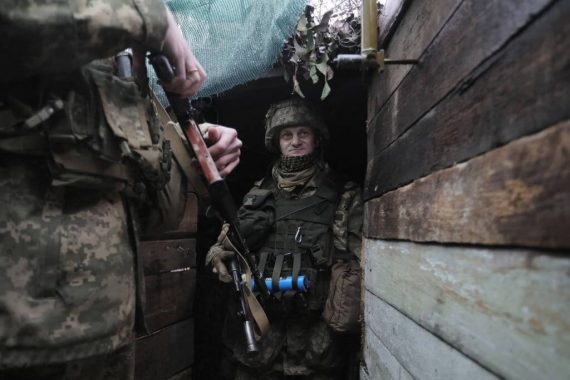Reports from the Russian side of the Russia-Ukraine border suggest that a large-scale military mobilization is underway. Experts warn that mobilization of such intensity could only occur before a large-scale military invasion of a foreign country. Alarmed, Ukraine also mobilized its troops and declared that it will resist a possible Russian occupation by all means. The U.S. firmly asserted that there will be severe economic consequences in the form of sanctions should Russia take such a drastic step.
Wanting to keep Ukraine as a buffer zone between Russia and the West, Russia signals that the strengthening of the relations between NATO and Ukraine will invite a harsh Russian response. However, Russia’s security strategy and operation style as well as regional parameters show that a full-scale invasion of Ukraine is unlikely.
The statements of Russian officials, especially by Putin and Lavrov, show that Russia is keeping such an option on the table in response to NATO’s expansion further east. Therefore, the movements of Russian troops near Ukraine should be seen as brinkmanship aiming at getting concessions from the U.S. in Eastern Europe.
Following the annexation of Crimea by Russia in 2014, the military ties between Ukraine and NATO strengthened much to Russia’s anger. In other words, Russia’s attempts to bring Ukraine closer to its orbit were counterproductive. In 2017, Ukrainian Parliament approved NATO membership as a strategic and foreign policy objective.
Such an objective found its place in Ukraine’s new National Security Strategy in 2020. Ukraine currently receives military aid from the U.S. within the framework of Operation Fearless Guardian, mostly in the form of training. Ukraine has also purchased various types of weaponry from the U.S. Most recently, Ukraine deployed Turkish-made Bayraktar TB2 drones, which proved useful for reconnaissance flights and shooting strategic targets in the recent conflict between Armenia and Azerbaijan, in Syria, and in Libya.
The total number of mobilized Russian troops reached as many as 12,0000, including medical units, which could be useful in a full-scale invasion
These moves significantly angered Russia, which openly declared in an increasingly warning tone that Ukraine’s sliding to the West is not permissible. Meanwhile, Russian troop movements towards the Ukrainian border gained impetus throughout 2021. The total number of mobilized Russian troops reached as many as 12,0000, including medical units, which could be useful in a full-scale invasion. Russia also adopted a confrontational and threatening discourse against Ukraine, openly signaling the gravity of the issue with threats coming from the very top echelons of the Russian administration.
In parallel with the rapid escalation between Russia and Ukraine with troop movements and a war of words, the question being raised is “Will Russia invade Ukraine?” Considering Russia’s strategic priorities and current regional and international calculations, it is unlikely that Russia will dare to do so. Multiple aspects of the issue show that Russia’s primary aim is not to capture or to control Ukraine, but to keep the West away from its borders.
First, Russia already controls Eastern Ukraine through proxies and has already annexed Crimea. Following the annexation of Crimea, Russia aided the establishment of two unrecognized statelets in the Eastern Ukraine: the Donetsk People’s Republic (DPR) and the Lugansk People’s Republic (LPR). Russia has supported the DPR and LPR through military and financial means since the beginning of Ukraine’s civil war in mid-2014. Thanks to Russia, the DPR and LPR could resist the Ukrainian military and establish their statelets. Russia also made it easier for the “citizens” of the DPR and LPR to obtain Russian passports while providing social and economic assistance to the region.
Making Eastern Ukraine an official part of Russia would be pointless considering the backlash Russia could face from the international community.
As a result of these steps, the region became politically, socially, and economically integrated with Russia. In Crimea, the local Ukrainian and Crimean Tatar opposition to the annexation has been suppressed against the backdrop of the international community’s mild response. Moving beyond these areas or making Eastern Ukraine an official part of Russia would be pointless considering the backlash Russia could face from the international community.
Second, a full-blown invasion of Ukraine is incompatible with Russia’s strategic culture. Despite adopting an assertive military posture, Russia mostly employs cost-effective methods when reaching its goals through military means. For example, during the annexation of Crimea and the establishment of the DPR and LPR, Russia successfully established plausible deniability by employing soldiers without badges.
Recommended
Similarly, Russia prefers to utilize private security companies as, for example, in Africa and in the Middle East instead of risking its own soldiers. Moreover, as unrecognized republics, the DPR and LPR have precedents in the examples of Abkhazia and Transnistria. Therefore, even if Russia decides to escalate the conflict, a covert operation with plausible deniability instead of a large-scale military operation fits the Russian playbook.
Ukraine has vowed to resist the invasion to make such a scenario as costly as possible for Russia.
Third, a Russian invasion of Ukraine will be very costly for Russia. Ukraine has vowed to resist the invasion to make such a scenario as costly as possible for Russia. Invading a country with a 41 million population that is likely to help the Ukrainian troops wage a guerilla warfare on a terrain bigger than France can cost Russia immensely.
Having criticized the U.S. for the invasion of Iraq for years, it is unlikely that Putin would fall into the same trap. In the latest talks between Joe Biden and Vladimir Putin on December 7, the U.S. threatened Russia with economic sanctions, which might be useful in getting Russia to rethink its actions. Sanctions could cost Russia billions of dollars of future revenue and a loss of share in the European gas market. Earlier this year, Biden waived sanctions on the Nord Stream 2 pipeline project between Russia and Germany.

VIDEO: Russian Expansionism under Vladimir Putin
Since invasion is unlikely, Russia’s end game should be giving the message that all options are on the table if the West does not comply with Russia’s demands over Ukraine. Based on Lavrov’s words, Russia demands the reduction of NATO’s military presence around the Russian border, particularly in Poland and Romania.
Russia’s ultimate aim seems to be to secure its Western front with legal guarantees for the renunciation of further NATO expansion towards the east. Such a guarantee could enable Russia to create a new regional order in Europe. However, the United States, which Russia wants to see at the negotiation table, refuses to give any guarantees to Russia, and Ukraine maintains its intention to join NATO and the European Union. Russia’s threatening posture towards Ukraine adds insult to injury by making Ukrainians rally round their flag and reminding the U.S. of Russia’s projections. In the end, such acts of brinkmanship will not benefit Russia in achieving its strategic goals.
With all the scenarios considered, the most viable one for the near future is an escalation without a full-scale Russian military invasion of Ukraine. Russia will continue to take measures to keep Ukraine in its orbit while Ukraine and the West will be careful not to corner Russia. An escalation in the conflict zone is possible but only through covert means in accordance with the Russian playbook.





